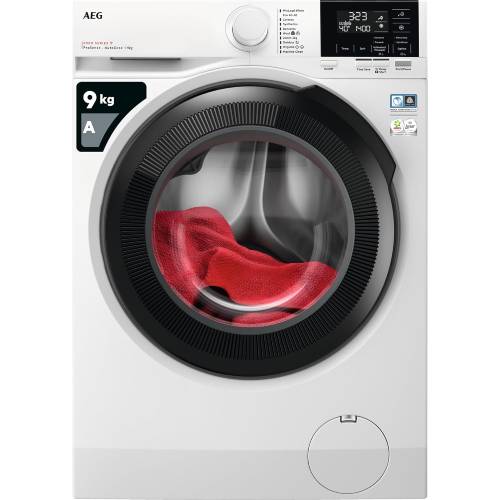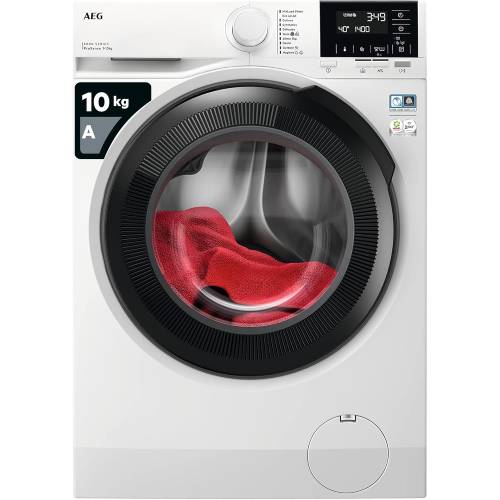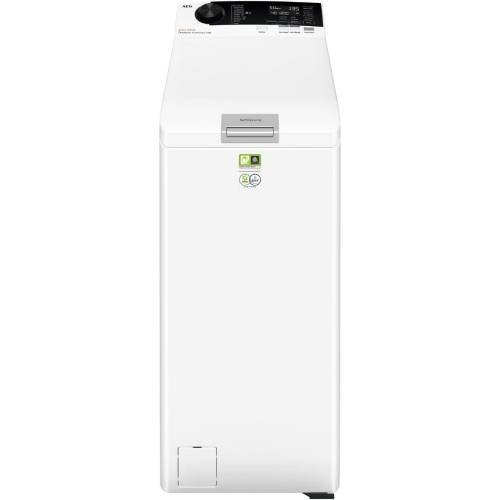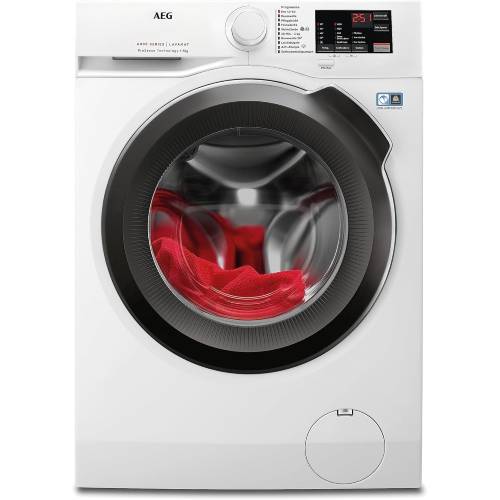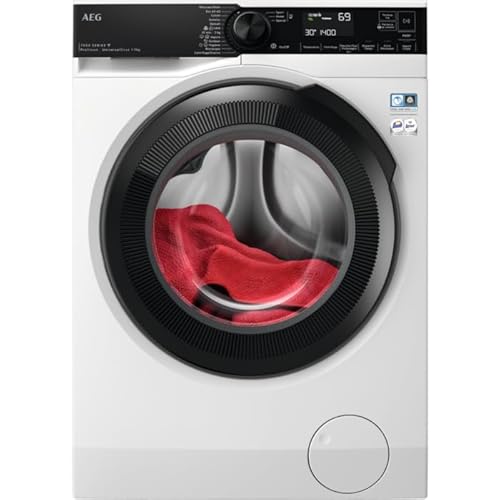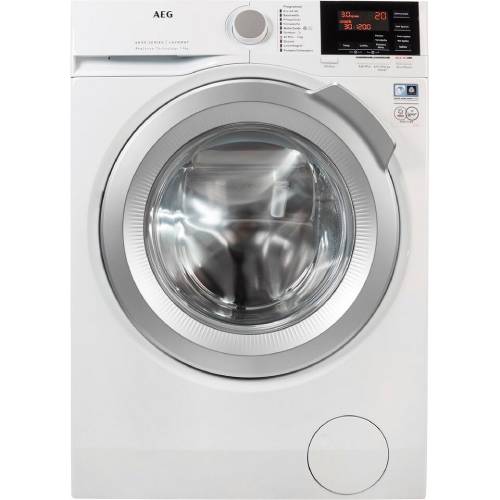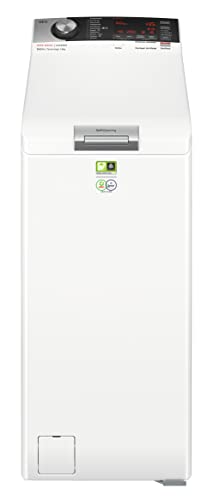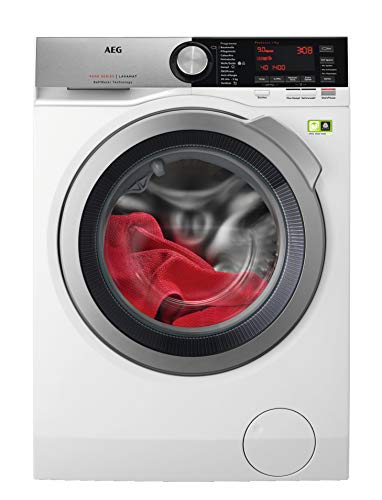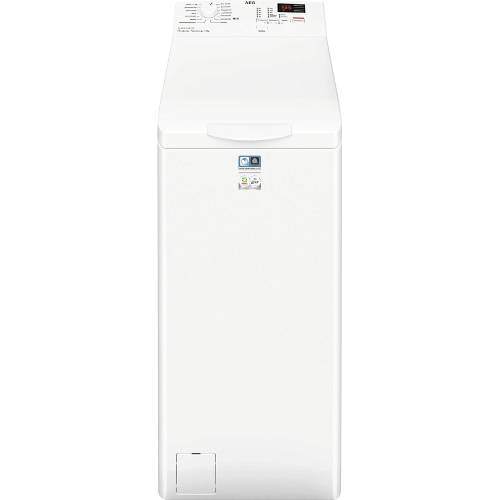Are AEG washing machines good?
AEG washing machines offer good performance but do not rank among the top brands. There are better washing machines available on the market. Currently, they are ranked #10 among all washing machine brands, with an overall score of 7.1 points. User ratings place them at #14 with a score of 8 points.
AEG manufactures solid washing machines, but if you are looking for the best, consider brands like Samsung, Miele, or LG.
(The evaluation considered 22 brands, excluding those with fewer than 6 products in the database.)
The chart below shows the ranking of washing machine brands based on their overall scores.
[horizontal-chart-39866564]
The best AEG washing machines (with the highest overall scores) are as follows.
- AEG LFR61944AD 6000 Series ProSense (Overall score: 7.7 points; Capacity: 9 kg)
- AEG L6FBA51480 6000 Series ProSense (Overall score: 7.22 points; Capacity: 8 kg)
- AEG LFR61144B 6000 Series ProSense (Overall score: 7.18 points; Capacity: 10 kg)
The following list includes the best AEG washing machines rated highest by users.
- AEG L6FBA51480 6000 Series ProSense (User score: 8.84 points; Capacity: 8 kg)
- AEG LFR61144B 6000 Series ProSense (User score: 8.44 points; Capacity: 10 kg)
- AEG LFR61944AD 6000 Series ProSense (User score: 8.44 points; Capacity: 9 kg)
What are the main advantages of AEG washing machines?
AEG washing machines have the following advantages compared to other brands.
- Lower water consumption: AEG washing machines consume an average of 43 litres per cycle, compared to the market average of 46 litres.
- Shorter ECO cycle: The ECO cycle in AEG washing machines lasts an average of 205 minutes, compared to the market average of 218 minutes.
- Prewash and anti-stain functions: All AEG models include these cycles, whereas only 70-80% of washing machines from other brands offer them.
- Specialised cycles: Many AEG models feature a Duvet or Anti-Allergy cycle.
- Adjustable cycle options: Most AEG washing machines include features like a fast function, anti-stain function, anti-crease function, rinse hold, Steam Plus, extra rinse function, extra quiet function, and SoftPlus.
- Safety and convenience features: Nearly all AEG washing machines include overflow protection, a laundry detection system (ProSense or PreciseWash technology), a Pause & add function, and a delay start option up to 20 hours.
- Advanced technologies: Many AEG models are equipped with steam technology (Anti-Allergy Steam or ProSteam), foam control system, AquaStop system, automatic drum positioning, and soft-opening systems in top-loading models. Some advanced models include automatic dosing (AutoDose), pre-mix technology (ÖkoMix/PowerSoft), and Wi-Fi connectivity via the My AEG Care app with the Favourite function.
- Special drum design: Most front-loading models are equipped with a GentleCare, ProTex, or Care Drum to protect delicate fabrics.
What are the main disadvantages of AEG washing machines?
AEG washing machines have the following disadvantages compared to other brands.
- Higher cost: AEG washing machines cost an average of £180 more than the market average (£560 compared to £380).
- Lower quality-price ratio: AEG washing machines score lower in quality-price ratio than the market average (6 compared to 7.1 points).
- Lower popularity: AEG washing machines are less popular compared to most other brands, with an average popularity score of 4.4 compared to 6 for the market average.
- Fewer washing programs: AEG washing machines usually have only 10 washing programs compared to the market average of 15. They often lack specialised cycles such as the Shirts cycle, Baby Care cycle, and rarely include Jeans or Hygiene cycles.
- Limited quick cycle options: AEG washing machines typically have just one quick cycle, while other brands often offer two or more.
- Longer quick cycle duration: The quick cycle in AEG washing machines lasts about 5 minutes longer than in other brands (20 minutes compared to 15 minutes).
- Missing features: AEG washing machines do not include soak function, Aqua+, wash assist, automatic drawer cleaning, load balancing system, or AI technology. Additionally, only a few include a self-cleaning program.
Who manufactures AEG washing machines?
AEG washing machines are produced by Electrolux, a Swedish company that acquired AEG’s appliance division in 1994, integrating the brand into its portfolio. Despite the acquisition, AEG washing machines continue to be manufactured in Germany, preserving their German engineering heritage.
Founded in 1883 in Berlin, AEG is renowned for its pioneering role in electrical engineering and home appliances. Its reputation for innovation and quality remains strong under Electrolux ownership. Established in 1919, Electrolux has become a global leader in home appliances, with a presence in over 150 countries and approximately 50,000 employees.
What are the different series of AEG washing machines?
AEG washing machines are available in the following series.
- 6000 Series: Offers essential features like ProSense technology, which detects load size and adjusts water, time, and energy accordingly. Includes the Time Saving option to cut wash times by up to 50% and an Anti-Allergy steam function for front-loading models (Anti-Allergy program for top-loading models). Features anti-crease function to reduce wrinkles and SoftPlus for better rinsing. The permanent magnet inverter motor ensures quieter operation. Some top-loading models feature LiquiDose technology for precise detergent dosing. Capacities range from 6 to 10 kg, with energy classes from A to C for front-loading models and D to F for top-loading models. Prices range between £400 and £750.
- 7000 Series: Builds on the 6000 series with additional features such as Eco TimeSave, which combines time and energy savings, and an improved anti-stain function. The Steam Plus option adds steam and anti-crease phase. The patented Universal Dose drawer is designed to dissolve all types of detergent, including PODS®. The ÖKOInverter motor ensures high energy efficiency. ProSteam technology reduces wrinkles by 66% and allows clothes to be refreshed without washing. Capacities range from 8 to 11 kg, with energy classes from A to C. Prices range between £500 and £1,150.
- 8000 Series: Includes all the features of the 7000 series with additional improvements. PreciseWash technology automatically adjusts settings based on load size, reducing energy, water, and time consumption by up to 40%. The PowerClean 59 min function removes up to 59 stains in under an hour, while the specially designed drum minimises fabric wear. Features PowerCare technology and ÖKOMix for improved detergent performance. Capacities range from 8 to 11 kg, with energy classes from A to B. Prices range between £500 and £1,150.
- 9000 Series: Introduces SoftWater technology, which softens water by removing harmful minerals, protecting fabrics. Combines this with the AbsoluteWash 49 min program, which washes clothes at 30°C in under an hour. Certified Woolmark Green for its Wool cycle. Capacities range from 8 to 10 kg, with energy class A. Prices range between £950 and £1,250.
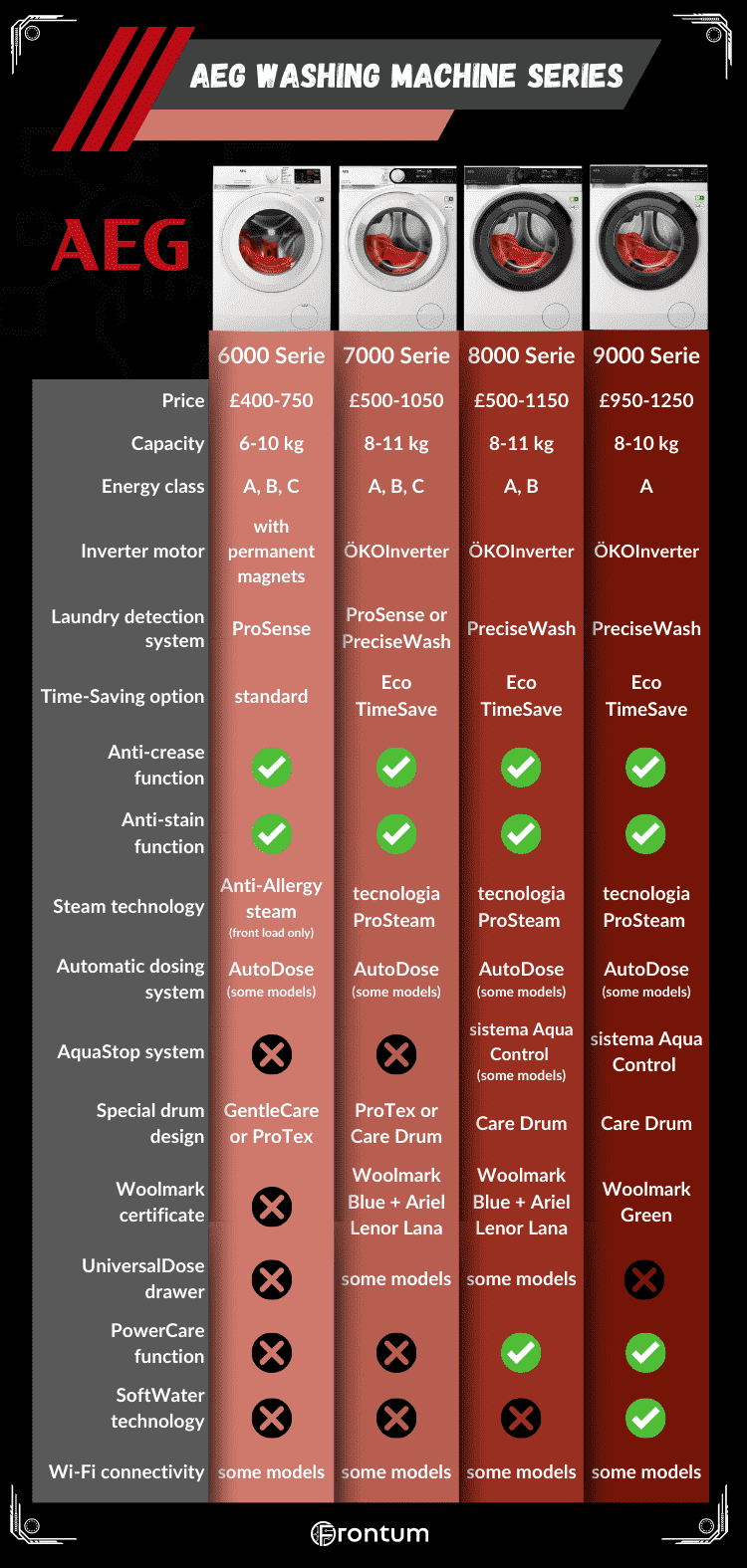
What is the warranty period for AEG washing machines?
AEG washing machines come with a 2-year warranty covering free repairs by authorised technicians. This includes labour, spare parts, travel, and product replacement. You can extend this warranty by subscribing to Protection: EASY (for one appliance) at £9.90/month or FAMILY (for multiple appliances) at £20.90/month. Additionally, registering the product extends the motor warranty to 10 years.
How much do AEG washing machines cost?
AEG washing machines have prices ranging from £400 to £1,250, with an average cost of approximately £690, ranking #19 among 22 brands (ranked from cheapest to most expensive). Higher-end models offer larger capacities, better energy efficiency, and advanced features. By comparison, the average price of a washing machine is around £460.
The most affordable AEG washing machines belong to the 6000 Series, priced between £400 and £750, while the 7000 Series goes up to £1,050. Models in the 8000 and 9000 Series can reach £1,250.
The chart below shows the cost distribution among AEG washing machines.
[vertical-chart-84377899]
In terms of quality-price ratio, AEG ranks #21 out of 22 brands, with an average score of 6 for quality-price ratio.
Note: Brands with fewer than 6 products in the database were not included in the ranking.
What should you consider when choosing the best AEG washing machine?
When choosing the best AEG washing machine, consider the loading type, capacity, dimensions, energy consumption, water usage, spin efficiency, noise levels, motor type, washing programs, and available features.
Front-loading or top-loading: which AEG washing machine type is better?
AEG front-loading washing machines achieve a higher overall score compared to top-loading models (7.2 vs. 6.3 points). Around 70% of AEG washing machines are front-loading.
The distribution of loading types among AEG washing machines is shown in the chart below.
[pie-chart-16981406]
AEG front-loading washing machines have the following advantages compared to top-loading models.
- Higher popularity: AEG front-loading washing machines score 4.7 in popularity, while top-loading models score an average of 3.7.
- Larger capacity: AEG front-loading washing machines have an average capacity of 8 kg and a drum volume of 55 litres, compared to 6 kg and 42 litres for top-loading models.
- Better energy efficiency: Front-loading AEG machines are typically rated energy efficiency class A, while top-loading models are usually rated E.
- Lower energy consumption: Front-loading AEG machines consume 49 kWh per 100 cycles, compared to 78 kWh per 100 cycles for top-loading models.
- Quieter operation: Front-loading AEG machines have a spin noise level of 74 dB and a washing noise level of 49 dB, compared to 77 dB and 56 dB for top-loading models.
AEG top-loading washing machines offer the following advantages compared to front-loading models.
- Lower cost: Top-loading washing machines cost around £600, about 25% less than front-loading models, which cost an average of £760.
- Better water efficiency: Top-loading washing machines use 2 litres less water on average (41 L vs. 43 L).
- Space-saving design: AEG top-loading washing machines occupy around 0.21 m³, compared to 0.33 m³ for front-loading models.
- Lighter weight: Top-loading washing machines are 15-20 kg lighter than front-loading models.
- Narrower width: Top-loading models are 20 cm narrower (40 cm vs. 60 cm).
- Easier to use: Top-loading washing machines are easier to load and unload.
- Fewer issues: Top-loading machines are less prone to mould and bad odours compared to front-loading models.
What capacities are available for AEG washing machines?
AEG washing machines have a capacity ranging from 3 to 10 kg. The most common capacities are 8 kg (30%), followed by 6 kg (15%) and 9 kg (19%). Drum volumes range from 40 to 60 litres, with an average of 43 litres, lower than the market average of 58 litres.
A 5-6 kg washing machine is suitable for couples, while a 7-8 kg model is ideal for families of 3-4 people. For large families or those who frequently wash bulky items, a capacity above 9 kg is preferable.
The capacities of AEG washing machines are presented in the following chart.
[pie-chart-51641081]
AEG washing machines occupy approximately 0.29 m³ of space, slightly more than the market average of 0.28 m³. Top-loading models are about 40 cm wide, while front-loading ones have a width of 60 cm. The depth ranges from 51 to 66 cm, meaning AEG does not offer slim models.
What is the energy efficiency of AEG washing machines?
AEG washing machines offer good energy efficiency, with ratings ranging from A to F. The 56% of models belongs to class A, 19% to class B, 7% to class C, 4% to class D, and 15% to classes E and F. Classes E and F mainly include top-loading models, which are less energy-efficient. AEG does not produce washing machines in class G.
The chart below illustrates the distribution of energy efficiency classes among AEG washing machines.
[pie-chart-67805725]
AEG series are distinguished by the following energy classes.
- 6000 and 7000 Series: Classes A, B, or C
- 8000 Series: Classes A or B
- 9000 Series: Exclusively Class A
AEG washing machines consume between 40 and 80 kWh per 100 cycles, with an average of 55.5 kWh. This ranks them 9th out of 22 brands for energy consumption (from lowest to highest). Class A washing machines consume less than 49 kWh per 100 cycles, while Class B models consume less than 55 kWh, varying by capacity.
Regarding water consumption, AEG washing machines use between 36 and 52 litres per cycle, with an average of 43 litres. This ranks them 2nd out of 22 brands for water consumption (from lowest to highest).
The following list shows the AEG washing machines with the lowest energy consumption.
- AEG L6FBA51480 6000 Series ProSense (Energy consumption: 47 kWh/100 cycles per 100 cycles; Capacity: 8 kg)
- AEG LFR61944AD 6000 Series ProSense (Energy consumption: 49 kWh/100 cycles per 100 cycles; Capacity: 9 kg)
- AEG LFR61144B 6000 Series ProSense (Energy consumption: 51 kWh/100 cycles per 100 cycles; Capacity: 10 kg)
What is the spin efficiency of AEG washing machines?
AEG washing machines have spin efficiency divided into two classes: B (93%) and C (4%). By comparison, the most common spin efficiency class on the market is B, representing 85% of washing machines, followed by class C (10%) and class A (5%).
Spin efficiency measures how effectively the washing machine removes water from clothes after spinning, directly impacting drying times and energy consumption.
The spin efficiency classes of AEG washing machines are presented in the chart below.
[pie-chart-97246553]
Spin efficiency is closely related to maximum spin speed. Higher speeds remove more water from clothes. AEG washing machines reach maximum spin speeds between 1200 and 1400 RPM, with 1400 RPM representing 59% of AEG washing machines, followed by 1200 RPM (26%). These values reflect market trends, where 60% of washing machines reach 1400 RPM and 22% reach 1200 RPM.
For reference, spinning at 1600 RPM leaves approximately 43% moisture in clothes, while 1400 RPM leaves 50% and 1200 RPM leaves 53%. Higher speeds are especially useful for reducing drying times, particularly if you do not use a dryer.
If you frequently wash delicate fabrics, consider the minimum spin speed. Lower speeds protect more sensitive fabrics. In AEG washing machines, the minimum spin speed ranges between 400 and 800 RPM, with 62% of machines reaching 400 RPM (in line with the market average of 67%).
How noisy are AEG washing machines?
AEG washing machines have spin noise levels ranging from 72 dB to 79 dB, with an average of 76 dB (in line with the market average). This places AEG 9th in the ranking of spin noise levels among 22 brands, ordered from quietest to loudest. Since spinning is the loudest part of the wash cycle, the spin noise level is the main indicator of a washing machine's overall noise level.
The distribution of spin noise levels among AEG washing machines is shown in the chart below.
[vertical-chart-30473628]
In terms of noise emission class, AEG washing machines fall into classes A, B, and C. The 52% of models are in class B (73-76 dB), 30% in class C (77-80 dB), and only 19% are in class A (below 73 dB).
The washing noise level, less significant as it is lower than the spin noise, ranges between 47 and 56 dB in AEG washing machines, with an average of 53 dB (in line with the market average).
How many washing programs do AEG washing machines offer?
AEG washing machines typically include 10 washing programs, fewer than other brands that generally offer 14 or more. However, models in the 7000, 8000, and 9000 series can connect to Wi-Fi and download approximately 20 additional programs via the My AEG Care app.
The distribution of available washing programs in AEG washing machines is illustrated in the chart below.
[vertical-chart-82733610]
The most common programs include Eco 40-60, Cotton, Synthetics, Delicates, Wool/Silk, Cotton 20°C, Spin, Duvet, 3 kg in 20 minutes, Easy Iron, and Anti-Allergy. The Anti-Allergy program removes over 99.99% of bacteria and viruses by maintaining temperatures above 60°C during the wash.
Advanced models also feature the following specialised washing programs.
- Steam Cycle (7000 series): prepares dry laundry for ironing or refreshes already worn clothes.
- Hygiene Cycle (7000 series): Swissatest-certified, removes over 99.99% of viruses and bacteria.
- MixLoad 69 min (some 7000 series models): balances time, energy efficiency, and fabric care.
- PowerClean 59 min (some 8000 series models): gentle cleaning through pre-mixing detergent with water, removing 59 stains in 59 minutes, even at 30°C.
- ÖKOPower Cycle (8000 and 9000 series): washes up to 5 kg quickly and efficiently in less than an hour.
- ColourPro Cycle (9000 series): protects colours at low temperatures.
Through the My AEG Care app, you can download additional programs such as Sportswear, Daily Training, Quilts, Football/Rugby Gear, Ski Gear, Sports Shoes, Bedding, Curtains, Pillows, Towels, Down Jackets, Pet Hair, Denim, Silk, Baby Clothes, Shirts, Cashmere Steam, Drum Clean, Quick Wash for a Single Item, Anti-Allergy Steam, and Easy Iron.
AEG washing machines lack some common programs available in other brands, such as the Shirts cycle (present in 42% of washing machines on the market), Baby Care cycle (39%), Jeans cycle (45%), and Hygiene cycle.
AEG washing machines are equipped with the following options to customise wash cycles.
- Fast Function (all AEG models): Time Saving (6000 Series; reduces wash time by up to 50%) and Eco TimeSave (7000, 8000, and 9000 Series; combines time and energy savings for the quickest, most energy-efficient wash).
- Anti-Stain Function (most AEG models): the Anti-Stain or Anti-Stain Plus option adds a stain removal phase to a program.
- Anti-Allergy Steam Option: maintains temperatures above 60°C for several minutes during the wash, eliminating viruses, bacteria, and allergens from clothes.
- Anti-Crease Function (6000 Series only): keeps the drum rotating gently with the door locked to reduce wrinkles.
- Steam Plus (7000 Series and later): adds a steam phase followed by a brief anti-crease phase at the end of the wash, reducing fabric wrinkles and easing ironing.
- Rinse Hold Function (all AEG models): keeps the laundry in water until you are ready for the spin cycle.
- Extra Rinse Function (available in 71% of AEG models): adds additional rinse cycles.
- Extra Silent Function: skips spin phases and finishes with clothes in water to reduce wrinkles.
- SoftPlus Option: ensures that fabric softener reaches every part of the laundry by using extra water to distribute it evenly and adding an additional rinse cycle.
- Eco Function (available in some models from the 7000 Series): reduces energy consumption while maintaining good washing results.
None of the analysed AEG washing machines include a soak function, Water+ function, or wash assist feature.
What are the common features of AEG washing machines?
AEG washing machines include between 9 and 15 features (compared to the market average of 10).
The chart below illustrates the distribution of features among AEG washing machines.
[vertical-chart-86032221]
Almost all AEG washing machines offer the following features.
- Laundry Detection System: ProSense technology (6000 Series and some 7000 Series models) or PreciseWash technology (8000, 9000 Series and some 7000 Series models). Both use sensors to measure the load and adjust the wash cycle, but PreciseWash makes more precise adjustments for greater energy and water efficiency.
- Foam Control System: detects and automatically adjusts foam levels during washing.
- Pause & Add: pauses the wash cycle to add forgotten items.
- Delay Start Option: allows you to schedule the start of the cycle up to 20 hours in advance.
- Overflow Protection: monitors the water level in the drum and automatically removes excess water if needed.
- Soft-Opening System (in top-loading models): allows gentle opening with the press of a button.
- Automatic Drum Positioning (in top-loading models): aligns the drum for easy access to clothes at the end of the cycle.
Most AEG front-loading models feature a special drum design. The 6000 Series comes with the GentleCare Drum (with more holes to reduce fabric deformation) or the ProTex Drum (with smaller holes to reduce pressure on fabrics). The 7000 Series can also include the ProTex Drum, and some models feature the Care Drum (with a woven interior and water-covered holes that reduce fabric friction, improve washing performance, and ensure gentle garment care). The 8000 and 9000 Series both use the Care Drum.
The 6000 Series also includes Anti-Allergy Steam, while the 7000 Series and later feature AEG ProSteam technology (adds steam at the end of the cycle to eliminate wrinkles).
The 8000 and 9000 Series feature pre-mixing technologies such as ÖkoMix/PowerCare or UniversalDose, which thoroughly mix detergent and softener with water before use. Models in the 9000 Series are also equipped with SoftWater technology, using an integrated water softener to remove harsh minerals from tap water, protecting fabrics and improving detergent effectiveness. Some models include the AquaStop system and Wi-Fi connectivity, allowing control through the My AEG Care app.
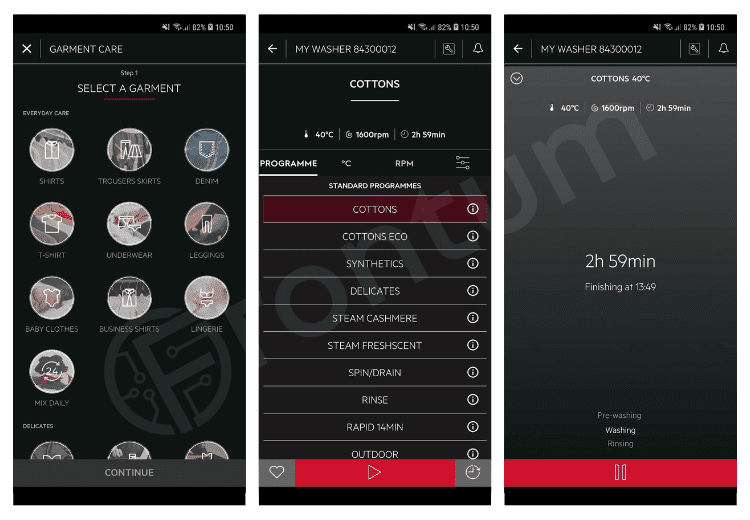
The 8000 and 9000 Series feature pre-mixing technologies such as ÖkoMix/PowerCare or UniversalDose, which thoroughly mix detergent and softener with water before use. Models in the 9000 Series include SoftWater technology, using an integrated water softener to remove harsh minerals from tap water, protecting fabrics and improving detergent effectiveness. Some models feature the AquaStop system and Wi-Fi connectivity (with control via the My AEG Care app).
Advanced AEG washing machines feature an automatic dosing system called AutoDose, which dispenses the exact amount of detergent and softener needed for each load. It uses intelligent sensors to weigh the laundry and calculate the optimal dosage. Other AEG washing machines feature a drawer called Liquidose, which releases detergent into the drum at the right moment, or UniversalDrawer, which accommodates all types of detergents, including liquid, powder, and PODS, ensuring they dissolve completely and quickly (even at low temperatures and during short cycles).
On the downside, no AEG washing machines include automatic drawer cleaning, a load balancing system, or AI technology, and very few include a self-cleaning program.

